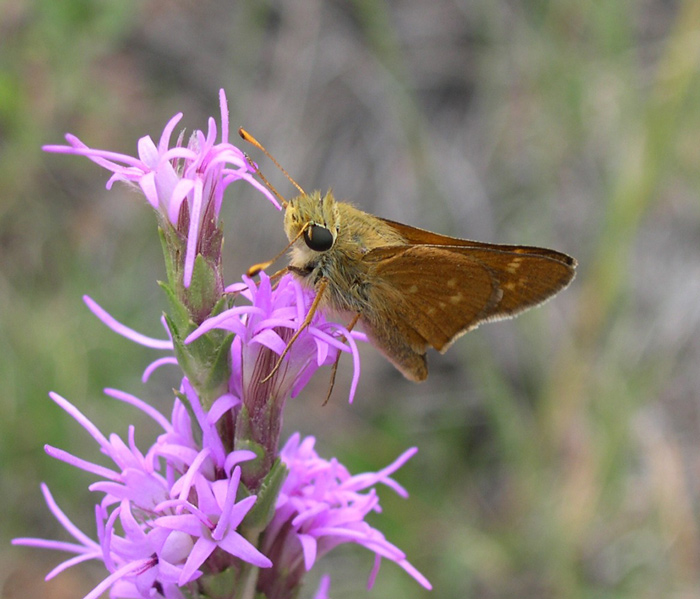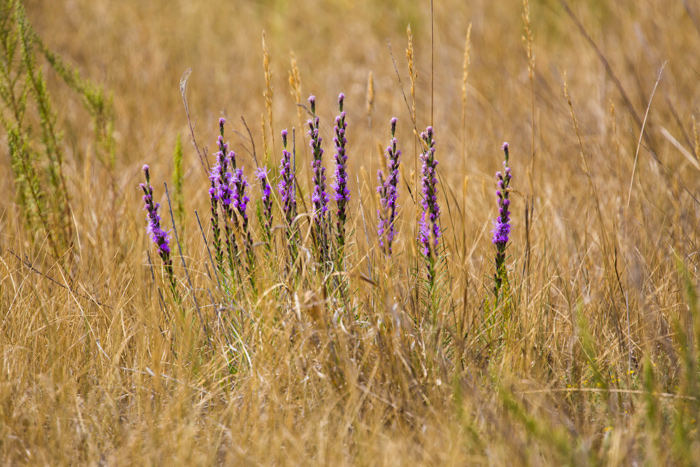Blazing Star/Dotted Gayfeather
- Liatris punctata Hook
- Aster Family (Asteraceae)
Narration:
General Information
- Plants: Perennial herbs with a single, erect stem. 4–16 inches tall. Leaves narrow, up to 6 inches long, but progressively smaller towards the top of the stem, and covered with tiny glandular dots that are visible when held up to the light.
- Flowers: Heads with only disk flowers (no rays), arranged in cylindrical spike-like clusters of sixteen to thirty-five pinkish purple florets.
- Fruits: Achenes with finely barbed pappus.
- Flowering Season: July to October.
- Habitat/Range: Dry, sandy soils of prairies and open woods of the High Plains east of the Continental Divide.1
Blackfeet Ethnobotany*
by Darnell and Smokey Rides At The Door
The Blackfeet name for dotted gayfeather is Mais Stu Nii Taa, translating to crow foot. The root of this plant is still used to cure stomach aches and occasionally eaten as a food. A tea is brewed to help liver, kidney, and bladder ailments.2
From the Journals
by H. Wayne Phillips
Dotted Blazing Star was not known to have been collected on the Lewis and Clark Expedition or mentioned in the Expedition journals, but two closely related species of the same genus were collected: Rough Blazing Star (Liatris aspera) and Tall Blazing Star (Liatris pycnostachya).3
A specimen of Rough Blazing Star was collected and still exists in the Academy of Natural Sciences of Philadelphia with a label on which Lewis wrote, “No. 58 12th September. growth of high & dry prarie.” Rough Blazing Star differs from the Dotted Blazing Star by being a taller, wider spreading plant, though their blooms appear similar. The blooms of Rough Blazing Star branch from the main stalk via smaller stems, whereas with Dotted Blazing Star, the blooms are concentrated around the main stalk.4
On September 12, 1804, the expedition passed 'Troublesom Island," now known as Durex or Hiram Wood Island, in present-day Brule County, South Dakota, below the mouth of the White River. Clark wrote:
at the upper pt of this Island the river was so crouded with Sand bars that we found great dificulty in getting the boat over, she turned on the Sand 4 times and was verry near turning over. We camped on the L. S. [larboard side] near a village of Prarie Dogs.5
It is presumed that this specimen of gayfeather was collected from a nearby prairie.
Additional Information: Many medicinal uses are known from its roots. Globally, there are 45 varieties of gayfeather plants. Though there are many common names of blazing star, the common names containing ‘dotted’ come from the translation of punctata, meaning ‘dotted’, is derived from the resin dots noticeable on the undersides of the leaves. The roots of this flower grow deeper into the soil than other Liatris plants, making it incredibly drought tolerant.6
*While traditional medicine is still practiced in many cultures including the Blackfeet culture and has many uses, please do not consume any plant material without consultation of a health professional.

By Jim Pisarowicz, U.S. National Park Service.

By Mike Elson, U.S. Forest Service.

Rocky Mountain Arsenal National Wildlife Refuge, Denver, Colorado. By Wikimedia Commons user cricketsblog. Permission to use granted under the Creative Commons Attribution-ShareAlike 2.0 Generic (CC-BY-SA 2.0) license.
Notes
- "Liatris punctata Hook," United States Department of Agriculture Natural Resources Conservation Service Plant Database, plants.usda.gov/home/plantProfile?symbol=LIPU.
- All ethnobotanical information was given or verified by Smokey Rides At The Door and Darnell Rides At The Door. Initial research came from Native American Ethnobotany Database. Please be advised that not all studies included are correct and to consult with Native community members to verify information.
- H. Wayne Phillips, Plants of the Lewis and Clark Expedition (Missoula, Montana: Mountain Press Publishing Company, 2003). H. Wayne Phillips graciously donated his expertise on this subject by writing this narrative.
- "Liatris aspera Michx," United States Department of Agriculture Natural Resources Conservation Service Plant Database, plants.usda.gov/home/plantProfile?symbol=LIAS.
- The Definitive Journals of Lewis & Clark, Gary Moulton, ed.
- "Blazing Stars (Gayfeathers; Liatris)," Missouri Department of Conservation, mdc.mo.gov/discover-nature/field-guide/blazing-stars-gayfeathers-liatris.


